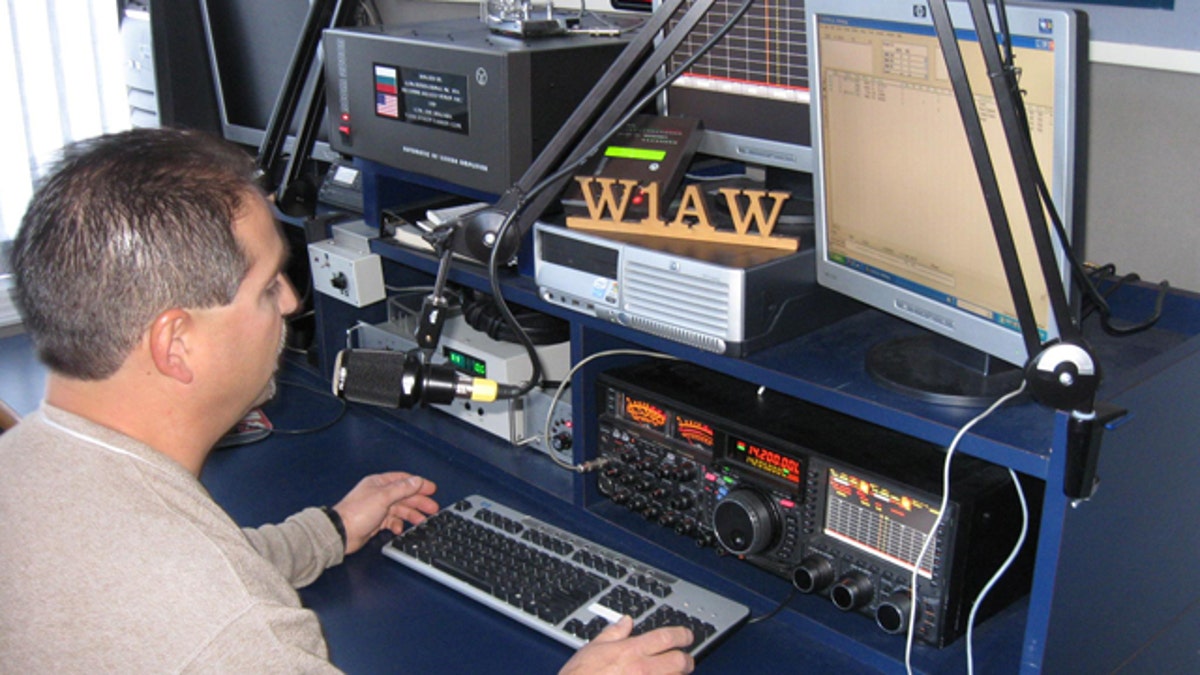
Nov. 16, 2011: Joe Carcia mans the mic at W1AW at the American Radio Relay League Headquarters in Newington, CT. (Allen Pitts / ARRL)
Fresno, Calif. – iPhone, beware?
The newest trend in American communication isn't another smartphone from Apple or Google but one of the elder statesmen of communication: Ham radio licenses are at an all time high, with over 700,000 licenses in the United States, according to the Federal Communications Commission.
Ham radio first took the nation by storm nearly a hundred years ago. Last month the FCC logged 700,314 licenses, with nearly 40,000 new ones in the last five years. Compare that with 2005 when only 662,600 people hammed it up and you'll see why the American Radio Relay League -- the authority on all things ham -- is calling it a "golden age."
"Over the last five years we've had 20-25,000 new hams a year," Allen Pitts, a spokesman for the group, told FoxNews.com.
The unusual slang term -- a "ham" is more properly known as an amateur radio operator -- described a poor operator when the first wireless operators started out in the early 1900s. At that time, government and coastal ships would have to compete with amateurs for signal time, because stations all battled for the same radio wavelength. Frustrated commercial operators called the amateurs “hams” and complained that they jammed up the signal.
People like John Pritchett have used the slang term ever since.
“It takes an inquisitive mind that wants the challenge to speak with the rest of the world,” Pritchett told FoxNews.com. “I meet a lot of people as a result amateur radio. It’s a fascinating experience to meet somebody who you’ve talked to for years -- when you finally meet them and go, wow, that’s you.”
Pritchett has been a ham for over 35 years. He sits in his ham shack slowly turning the dial on his amateur radio and listening attentively for a voice through the high radio frequency. But he’s not looking for aliens: Pritchett is dialing in to make contact with someone around the world.
“W6JWK, This is John in Fresno, California,” he says.
Pritchett can communicate with people around the globe or even astronauts in space by talking through his microphone or using Morse code.
With more people joining the hobby, local ham radio businesses are growing as well. Amateur Electronics Supply in Las Vegas sells everything to do with ham radios, from transceivers, amplifiers and antennas to handhelds.
“We have clientele from all walks of life," manager Luke Rohn told FoxNews.com. "We have church groups who are interested in ham radio for a viable source of communication in times of natural disaster. We have young kids that find ham radio interesting. Maybe they’ve heard about it through their father and grandfather and it’s a lot of fun for them.”
According to the American Radio Relay League, retirees and emergency groups are among the main reasons for the nearly 30,000 new hams that pick up the hobby each year.
Ham is a boon for safety as well as a fun pastime: When normal communications methods fail and cellphone towers are jammed, ham radios will still work and can help out in disaster situations, because they don’t require towers to relay the signal.
“Amateur radio came into play very much during the major earthquake in the Bay Area in 1989. The only thing I had was a little handheld radio. Nothing else worked, telephones didn’t work, cellphones didn’t work, amateur radio just kept right on working,” Pritchett said.
Looking to ham it up a bit with some friends? Try a fox hunt -- the radio equivalent of ham-to-ham combat. In a fox hunt, local amateur radio clubs search for a transmitter (called the fox) using their homemade antennas.
“The fox hunting is really fun -- the thrill of the chase, the competition of being the first to find the transmitter,” said Rob Mavis, president of the Clovis Amateur Radio Pioneers club in Clovis, Calif.
Ham radio is inexpensive fun, as well: All you need is a couple hundred bucks to get started and a FCC license -- which is free, but requires a $10 to $12 fee to cover expenses.
So join the latest craze -- no iPhone app required.
